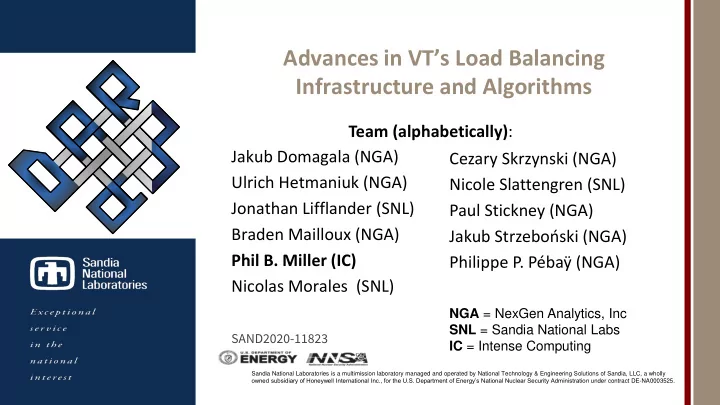

Advances in VT’s Load Balancing Infrastructure and Algorithms Team (alphabetically) : Jakub Domagala (NGA) Cezary Skrzynski (NGA) Ulrich Hetmaniuk (NGA) Nicole Slattengren (SNL) Jonathan Lifflander (SNL) Paul Stickney (NGA) Braden Mailloux (NGA) Jakub Strzeboński (NGA) Phil B. Miller (IC) Philippe P. Pébaÿ (NGA) Nicolas Morales (SNL) NGA = NexGen Analytics, Inc SNL = Sandia National Labs SAND2020-11823 IC = Intense Computing Sandia National Laboratories is a multimission laboratory managed and operated by National Technology & Engineering Solutions of Sandia, LLC, a wholly owned subsidiary of Honeywell International Inc., for the U.S. Department of Energy’s National Nuclear Security Administratio n under contract DE-NA0003525.
What is DARMA? A toolkit of libraries to support incremental AMT adoption in production scientific applications Module Name Description DARMA/ vt Virtual Transport MPI-oriented AMT HPC runtime DARMA/ checkpoint Checkpoint Serialization & checkpointing library DARMA/ detector C++ trait detection Optional C++14 trait detection library DARMA/ LBAF Load Balancing Analysis Python framework for simulating LBs and Framework experimenting with load balancing strategies DARMA/ checkpoint-analyzer Serialization Sanitizer Clang AST frontend pass that generates serialization sanitization at runtime DARMA Documentation: https://darma-tasking.github.io/docs/html/index.html
Load Balancing R&D Lifecycle ▪ Application runs with VT runtime with designated phases and subphases ▪ VT exports LB statistics files containing object loads, communication, and mapping ▪ LBAF loads the statistics files, and simulates possible strategies ▪ LBAF analyzes the mapping and can produce a new mapping with an experimental LB implemented in Python ▪ LBAF exports a new set of mapping files ▪ The application can be re-run with StatsMapLB to follow the LBAF-generated mapping and measure the actual impact ▪ Process can be iterated, shortening LB development and tuning cycle
Phase Management ▪ A phase is a collective interval of time over all ranks that is typically synchronized ▪ In an application, a phase may be a timestep ▪ In VT parlance, a phase will often be a “collective epoch” under termination detection ▪ Load balancing in VT fundamentally operates over phases ▪ A phase can be broken down into subphases ▪ A subphase is typically a substructure within a phase of an application’s work that has further synchronization ▪ Creates vector representation of workload ▪ We have explored the idea of further ontological structuring for the purpose enriching LB knowledge, but so far have only implemented phases and subphases
Phase Management ▪ Building general interface for general phase management ▪ Many components can naturally do things at phase boundaries ▪ LB ▪ Running a strategy (or several) and migrating objects accordingly ▪ Outputting statistic files ▪ Tracing ▪ Specifying which phases traces should be enabled for which ranks ▪ Specifying phase intervals for flushing traces to disk ▪ Memory levels/high-water watermark for runtime/application usage ▪ Diagnostics ▪ Just finished developing a general diagnostic framework for performance counters/gauges of runtime behavior (e.g., messages sent/node, bytes sent/node, avg/max/min handler duration) ▪ Checkpointing of system/application state ▪ Termination ▪ Recording state of epochs for debugging purposes
Phase Management ▪ A phase is a collective interval of time over all ranks that is typically synchronized ▪ In an application, a phase may be a timestep ▪ In VT parlance, a phase will often be a “collective epoch” under termination detection ▪ Load balancing in VT fundamentally operates over phases ▪ A phase can be broken down into subphases ▪ A subphase is typically a substructure within a phase of an application’s work that has further synchronization ▪ Creates vector representation of workload ▪ We have explored the idea of further ontological structuring for the purpose enriching LB knowledge, but so far have only implemented phases and subphases
EMPIRE Load Structure – Phases, Subphases, Iterations
Subphase Vector Loads ∀ 𝑜 𝑏 𝑞𝑜 = 1 𝑴: ℝ 𝑂×𝑇 𝑩: 𝑄×𝑂 𝑢 𝑡 = max 𝑥 𝑞𝑡 𝑿 = 𝑩𝑴 𝑢 = 𝑢 𝑡 𝑞 𝑞 𝑡 𝑄 × 𝑇 Object Object Total Subphase A ssignments L oads Time Times Objective Function: 𝑢 1 𝑢 2 𝑢 3 𝑢 4 𝑢 5 min 𝐵 𝑢
Subphase Vector Loads ▪ From 0-1 optimization to smaller Integer Program optimization 𝑩: 𝑄×𝑂 𝑏 𝑞𝑜 = 1 ⟺ 𝑛 𝑜 = 𝑞 𝑁: ℕ 𝑂 Object Object A ssignments M appings ▪ Replace with to (partially) linearize 𝑢 𝑡 = max 𝑥 𝑞𝑡 ∀ 𝑞 𝑢 𝑡 ≥ 𝑥 𝑞𝑡 𝑞 ▪ Plug this in to standard solvers ▪ Possibly MPI-based for live use!
Load Modeling ▪ When a selected strategy runs after a phase completes, it has access to data from the application’s execution ▪ Load models provide a novel mechanism for manipulating how the load balancer observes instrumented data from phases and subphases, past and future ▪ The most basic, naïve model would read raw instrumented data and assume it persists to the next phase/subphase to perform task assignment calculations for the subsequent phase ▪ Explicit embodiment of “principle of persistence” ▪ Offers configuration, alternatives ▪ Composable functions, easy extension ▪ Can also map vector of per-subphase data to scalars for current strategies
Load Modeling struct PhaseOffset { int phases; static constexpr unsigned int NEXT_PHASE = 0; unsigned int subphase; static constexpr unsigned int WHOLE_PHASE = ~0u; }; class LoadModel { virtual TimeType getWork( ElementIDType object, PhaseOffset when ) = 0; // ... }; Default: NaivePersistence . Norm(1) . RawData
Load Balancing Strategies
Conclusions and Future Work ▪ Increase expressiveness of load data ▪ Shorten LB development and tuning cycles ▪ Improve abstractions in real implementations ▪ Formalize time-vector balancing challenge ▪ Can actually try out dedicated solvers and general heuristics
Recommend
More recommend